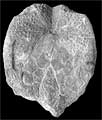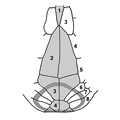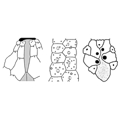The original line drawings of Manzoni are clearly wrong in their depiction of plating. Mortensen (1950) was mislead by the inaccurate drawings and assumed that this taxon had no subanal fasciole and no adproctal prolongation of ambulacral plates behind the episternals. The photographic illustrations and description of Stefanini (1908) show that there is a subanal fasciole and that the ambulacral plates indent behind the episternals, which is confirmed by new plate drawings by Borghi (2013). The taxon is thus close to Linopneustes, differing primarily in having petals that converge distally rather than remaining broadly open. In addition Mazettia differs by its depressed and slightly arched lateral profile and the elongate and posteriorly pointed outline (Borghi 2013).
Perispatangus Fourtau, 1905, from the Eocene is poorly known and is based on a smaller individual. However, like Mazettia it has a shallow but distinct frontal sulcus, and with better knowledge it seems likely that the two may prove synonymous.
Mazettia is distinguished from Spatangus, which some authorities have associated it with, by its elongate labral plate and triangular plastron. It is closer to Maretia, but differs from that genus in having a fully tuberculate plastron and well formed frontal sulcus.
Spatangus canavarii de Loriol, 1882 is a synonym of the type species according to Stefanini. The type material shows a thin peripetalous fasciole running close to the ambitus and enclosing the primary aboral tubercles.
Spatangus canavarii de Loriol is a synonym of the type species according to Stefanini.
Stefanini, G. 1908. Echinidi del Miocene Medio Dell'Emilia. Palaeontographica Italica 14, 65-119, pls, pls 13-16.
Lambert, J. 1915.Description des echinides des Terrains Neogenes du Bassin du Rhone. Memoires de la Societe Paleontologique Suisse 41, 155-240, pls 13-17.
Borghi, E. 2013. Mazettia (Maretiidae) un caratteristico echinoide del Miocene dell'Emilia-Romagna. Notiziario naturalistico della Societé Reggiana di Scienze Naturali 2013, 9-20.






